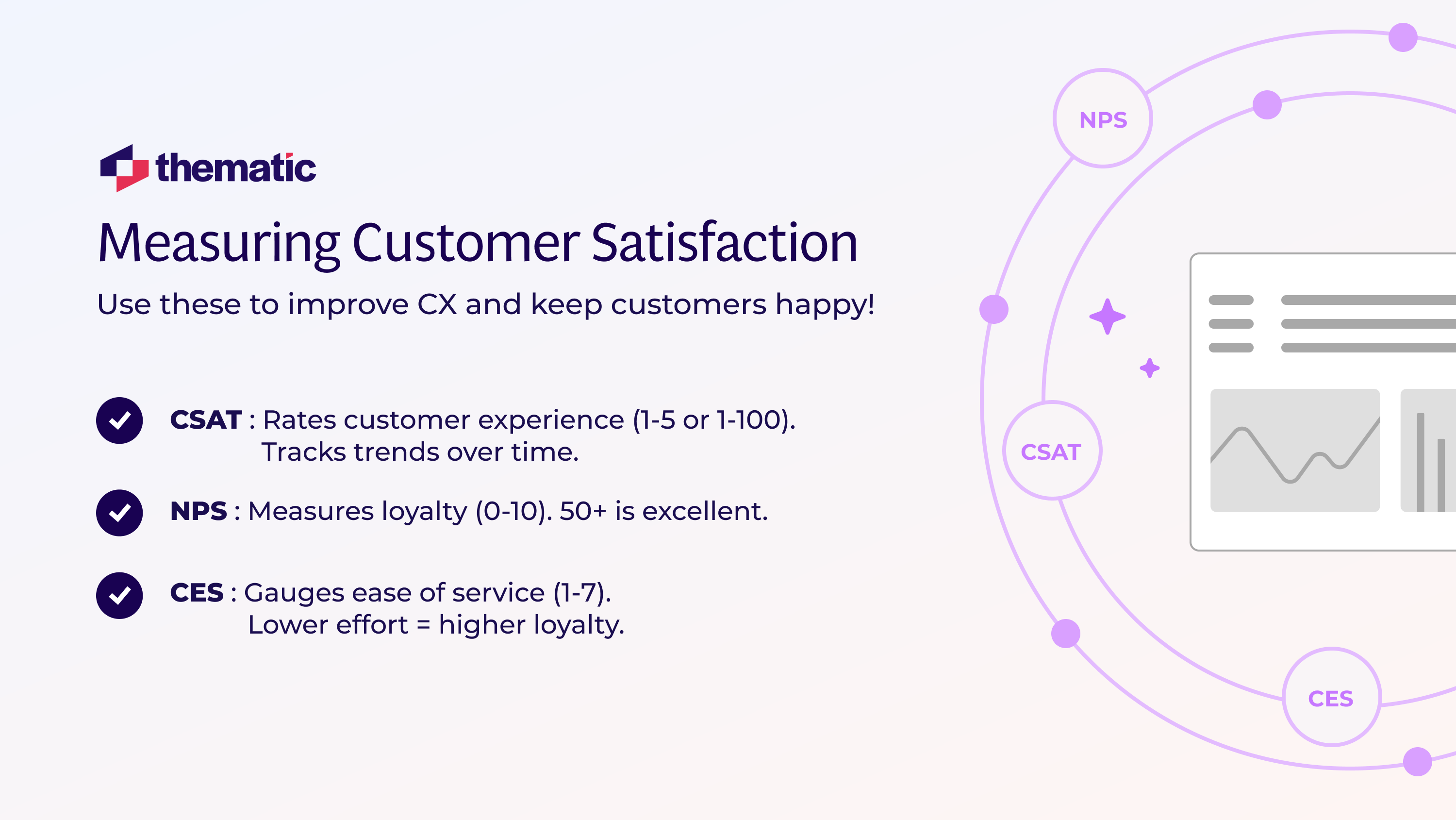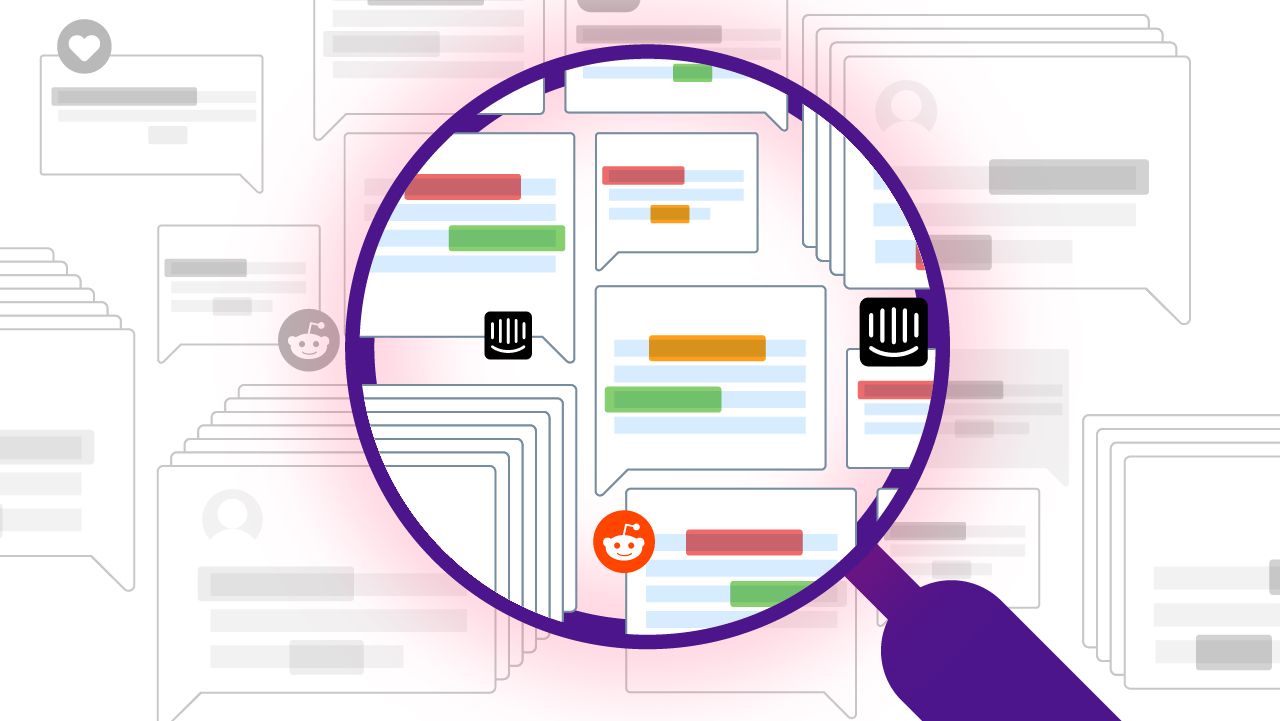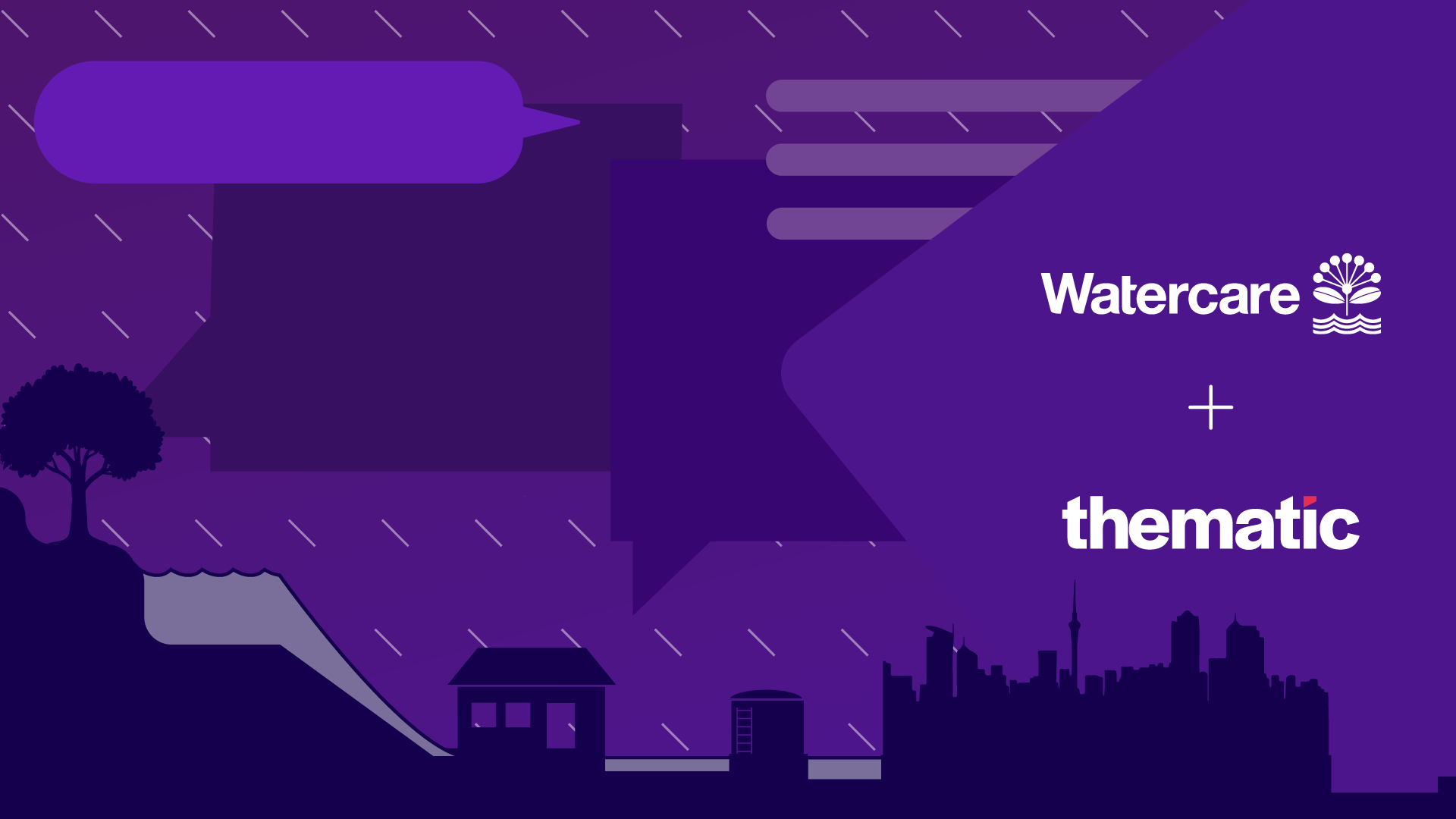
How to measure customer satisfaction: the complete guide
A clear strategy to measure and boost customer satisfaction. Turn frustrations into loyalty and ensure your business stays on the right track.
You can’t improve what you don’t measure—and that includes customer satisfaction. But how do you know if your customers are truly happy? Are your efforts making a difference, or are dissatisfied customers slipping away?
Tracking customer satisfaction isn’t just a nice-to-have—it’s essential. Happy customers stick around, spread the word, and drive business growth. Unhappy ones? They leave, and worse, they take others with them.
That’s why measuring customer satisfaction matters. By identifying gaps and trends, you can turn frustrations into loyalty and ensure your business stays on the right track.
In this guide, we’ll cover:
- What customer satisfaction is
- Why it’s important to measure
- Key customer satisfaction metrics
- The best ways to measure it
- The difference between satisfaction and loyalty
- How to take action and improve
By the end, you’ll have a clear strategy to measure and boost customer satisfaction—helping your business thrive.
What is customer satisfaction?
Before you can measure customer satisfaction, you need to understand customer satisfaction.
Customer satisfaction “is a measurement of how happy (or unhappy) customers are with a company's products, services or experience. Customer satisfaction consists of a customer's perceived quality, value and expectations of your company and what you offer,” notes careers site Indeed.
Satisfied customers tend to be repeat customers. It also helps expand your business, such as through referrals and positive reviews.
On the flip side, dissatisfied customers can hurt your brand. Approximately “50 percent of customers will switch to a competitor after just one bad support experience,” finds Zendesk. Plus, unsatisfied customers can prevent others from becoming your customers. I know I’m not the only one who passed on a business after reading a bad review.
Why measure customer satisfaction?
As the saying (sort of) goes, you don’t know what you don’t measure. If you want to know if you have happy customers that will help you grow, then you need to measure customer satisfaction.
We all want to feel loved, but customer satisfaction is more than that. As you develop benchmarks for your customer satisfaction, you can also see how your business improves. Suppose you start a new refund policy. You can then measure customer satisfaction to see if that correlates with an improvement.
Measuring customer satisfaction can also tie into areas such as talent management. Maybe your customer satisfaction surveys show that customers aren’t getting the help they need. That could mean your staff needs more training. Or maybe you need to hire more employees to share the workload.
Service quality and customer satisfaction come hand-in-hand. In fact, a recent study found that
“Consumers have become more discerning in choosing and utilizing goods, services, or products, ensuring they gain the utility and benefits they seek. In some cases, they are even willing to spend more to obtain high-quality products.”
A Zendesk survey even backs this study.
Clearly, service quality is an important consideration for customers’ purchase decisions. For companies, good service quality translates to better sales and revenue.
Bottom line: investing in measuring customer satisfaction pays off.

Case Study: How LendingTree Used Customer Feedback to Improve Experience
When measuring customer satisfaction, you’re not just collecting numbers; you draw insights from them and take action accordingly. That’s exactly what LendingTree did.
As an online loan marketplace, LendingTree receives over 20,000 customer comments every 90 days. With so much feedback, spotting patterns and making improvements felt overwhelming. But instead of ignoring the data, they leaned into it.
Using text analytics, they discovered a major pain point: loan leads were receiving calls at inconvenient hours due to time zone differences. This frustration was hurting customer satisfaction and lender engagement. By adjusting their outreach strategy, they reduced negative feedback and improved overall customer experience.
Key Takeaways:
- Customer feedback reveals hidden issues—but only if you listen.
- Small changes (like adjusting call times) can have a big impact.
- Automating data analysis makes customer feedback actionable, not overwhelming.
The lesson? Tracking customer satisfaction isn’t just about measurement—it’s about making better decisions that keep customers happy and businesses thriving.
So, in the next section, let’s talk about what you should measure.
Key metre customer satisfaction
Measuring customer satisfaction may seem tough. It’s not like you can use a tape measure. But in a way, you can put customer satisfaction on a scale. How? By using customer satisfaction metrics. Some of the more common ones include:
Customer Satisfaction Score
A customer satisfaction score (CSAT) can be a brand’s bread-and-butter customer satisfaction metric. It simply assigns a value to customers’ self-reported overall satisfaction. For example, a customer support team might ask customers to rate a recent service experience on a scale of 1-100. Or, a CSAT survey might ask respondents how satisfied they are with a purchase on a simple 1-5 scale.
Although CSATs are common, there’s not necessarily one standard measurement. The scales and questions used can vary, so a score may not be comparable from one brand to another. But don’t fret. If you measure your own company’s CSAT score, you can see how that changes over time to see if you’re moving in the right direction.
Net Promoter Score℠
Another one of the more common metrics used to measure customer satisfaction is the Net Promoter Score (NPS®), created by consultancy Bain & Company. The score works by asking customers to rate how likely they’d be to recommend a company or product/service on a scale of 0 to 10. “Ratings of 9 or 10 indicate promoters; 7 and 8, passives; and 0 through 6, detractors. The Net Promoter Score is simply the percentage of promoters minus the percentage of detractors,” explains Bain. So, the scale runs from -100 to 100.
Determining your NPS could be more valuable than just averaging customer satisfaction scores. That’s because it gives you a clearer idea of where you stand among those with the strongest views. If you have a low NPS score, that’s reason to worry. Why? Because those dissatisfied customers might convince others to not buy from you. On the other hand, a high NPS tells you that you have a strong base of customers who can be advocates for your brand.
In general, a score that’s a net positive (above 0), shows you’re on the right track. What defines a ‘good’ or ‘great’ score is dependent on the industry. The creators of NPS say that anything above 20 is favourable. 50+ is excellent and 80+ is “world class”.
Customer Effort Score
We all want low-effort interactions when it comes to spending our hard-earned money. That’s why you should measure your customer effort score (CES). This metric was created by CEB, which is now part of consultancy Gartner.
To measure CES, ask customers on a scale of 1-7 whether they agree it was easy to resolve an issue (or a related question you want to ask). CES is then based on the percentage of customers who answer with a 5 or above, indicating they at least somewhat agree. “There’s a much bigger opportunity to build loyalty if customers can move out of active disagreement or neutral territory,” explains Gartner.
Customer Happiness Index
As you look to measure customer satisfaction, you may come across Hubspot’s customer happiness index (CHI). This metric is based on an internal algorithm at Hubspot (a marketing platform). It measures engagement with marketing actions, explains marketing agency Impulse Creative. However, CHI seems to have fallen out of favor in recent years, so we don’t think you need to measure this on your own. Still, it could be valuable to think about whether you have any unique data you can use to measure customer satisfaction.

Common ways to measure customer satisfaction
Have a good grasp on customer satisfaction metrics? Great! Then we’re on to the next step: collecting or organizing data to measure customer satisfaction. Common ways to do so include using:
Surveys
Many customer satisfaction metrics, including CSAT, NPS and CES, are based on customer surveys. You can also create your own custom surveys using a survey tool that ask respondents questions related to customer satisfaction to develop your own indicators. And then you can use a survey analysis tool to analyze and find insights in the responses.
For example, you may want to follow up on an NPS survey to determine what aspects of your brand a customer most enjoys. So, you might ask open-ended questions about that, like asking customers to describe their satisfaction level with a new feature you started offering. You can ask survey questions through essentially any medium. You can use email surveys, social media, your website, the phone, etc.
Other sources of customer feedback and insight
Survey responses help, but don’t put all your stock there. Some customers might be survey-shy and hold back information. And some might not want to fill out a formal survey, so you may have low response rates. That’s why you need to analyze other sources of customer feedback. Truth is, most companies already get a ton of feedback from existing channels. This feedback can occur across channels like:
- Email: Customers might complain or give praise while interacting with your customer support team through email.
- Social media: Even if customers don’t tag you or comment on your posts, they may still be talking about you on social. For many companies, there is a huge pool of untapped feedback on social media waiting to be analyzed.
- Online reviews: Check review websites like G2 or Capterra for customer feedback on your product. A lot of this feedback can be automatically pulled into feedback analytics platforms like Thematic for analysis.
- Phone: If a customer calls in, like for technical support, they may not be willing to stay on the phone for a formal survey. But they may still provide comments verbally that clues you in.
- In-person: In-person feedback might be more anecdotal, but it can still be a good way to measure customer satisfaction. For example, if you notice specific complaints popping up from retail customers in a store, that could be an area worth addressing. That may even be a predictor of future complaints that will start to show up in survey responses.
You can use a platform like Thematic to help make sense of all this customer feedback. Thematic uses NLP technology to structure and analyze text to find meaning and insights in feedback data. The great thing about the platform is that you can integrate, analyze and measure the dormant feedback you already have. Such as social comments, reviews, help tickets, surveys, metadata and more. And when you’re analyzing by the source of feedback this helps you to understand context, urgency and the level of effort needed to improve customer satisfaction.
Analytics
You might have certain internal analytics you can use to better measure customer satisfaction. For example, if you have a low CES, you might look at analytics around average customer wait time. If you can improve that aspect, you might see CES improve.
Or, you might look at analytics around repeat purchases to get a sense of customer satisfaction. If you sell something that’s designed to be purchased more than once, yet you’re not getting much repeat business, that could be an indicator of low satisfaction that you’d want to address.
What’s the difference between customer satisfaction and loyalty?
As you measure customer satisfaction, you may notice a correlation with customer loyalty. They’re two peas in a pod, but not the same pea. Customer satisfaction is about how customers feel when purchasing from your brand. Customer loyalty refers to whether customers are willing to stick with your brand long-term.
In general, customer satisfaction leads to customer loyalty.
As you build customer loyalty, you can reduce customer churn. Loyal customers will keep coming back rather than switching to competitors. A reduced churn rate can also make it easier to benchmark customer satisfaction. You don’t have to keep surveying new customers at the beginning of a customer journey. Instead, you can measure the same customers over time.

Thematic
AI-powered software to transform qualitative data into powerful insights that drive decision making.
How to start improving customer satisfaction
By this point, we hope you understand why and how to measure customer satisfaction. But what do you do from there? How can you make changes that improve customer satisfaction?
Start by addressing survey scores, online comments and other sources of customer feedback. Suppose you have a low CES due to long customer service wait times. That could be a sign you need to grow your team to meet customers’ expectations.
But you also don’t have to wait until problems show up in customer satisfaction metrics. Be proactive in solving customer problems. For example, you could use a feedback analytics solution like Thematic to identify emerging negative themes in feedback. You may see that ‘waiting times’ are impacting your metrics. The faster you can alert your team to this, and take action, the less negative impact you will see on your customer satisfaction metrics. The more steps you can automate in this process the better.
Only 13% of customers in a Gartner survey reported being on the receiving end of proactive customer service. But if you want to improve customer satisfaction metrics like CSAT, NPS and CES, you should be proactive, notes Gartner.
At the end of the day, if you want to improve your business, start measuring customer satisfaction. Find ways to make customers happier, and I bet your business will be happier too.

Want to learn more about how you can improve customer satisfaction? Take a look at Thematic’s library of insights on customer experience.
Frequently Asked Questions (FAQs)
How often should I measure customer satisfaction?
It depends on your business and goals. If you want to track general satisfaction trends, quarterly or bi-annual surveys work well. However, for customer support interactions or product launches, measuring satisfaction immediately after the experience gives real-time insights. Regularly checking different touchpoints ensures you’re always aware of potential issues before they escalate.
Can customer satisfaction be too high?
Yes, surprisingly! If satisfaction is too high, it might indicate that you're overspending on customer service or offering excessive perks that hurt profitability. It’s also possible that customers aren’t being completely honest in their feedback. A balanced approach ensures you’re meeting expectations without overextending resources.
What’s the best way to measure customer satisfaction for a new business?
For startups or new businesses, start with simple and direct surveys using CSAT or NPS. Use social media feedback, online reviews, and direct customer interactions as informal sources of insight. Over time, you can integrate more structured measurement tools as your customer base grows.
How do I get customers to respond to satisfaction surveys?
Low response rates can be a challenge, but you can improve participation by:
- Keeping surveys short (under 3 minutes).
- Offering incentives (discounts, freebies, or sweepstakes entries).
- Sending at the right time (immediately after an interaction).
- Personalizing the request (mention the customer’s name and specific purchase/service).
Stay up to date with the latest
Join the newsletter to receive the latest updates in your inbox.




